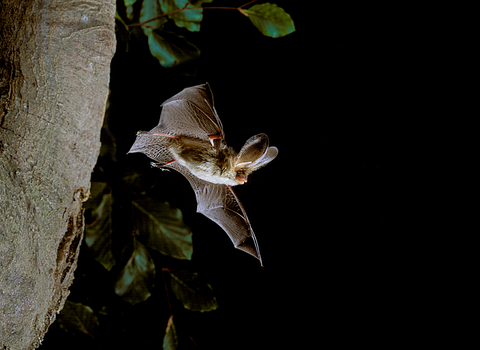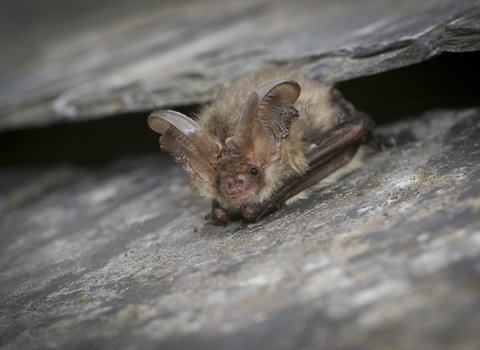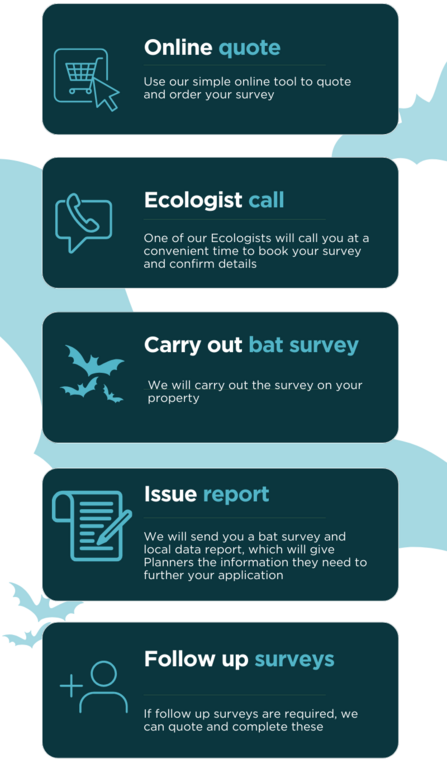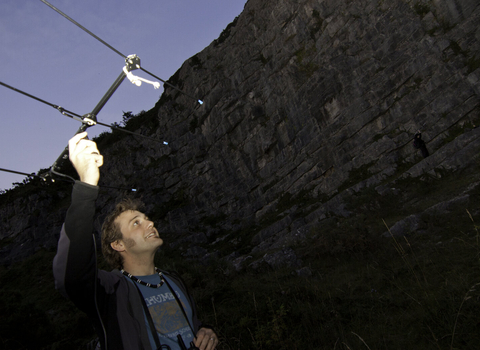
Have you been asked for a bat survey for your planning application or permission?
We can help. Our team of experienced Ecologists provide bat surveys throughout Oxfordshire, Buckinghamshire, Berkshire and neighbouring counties.

Brown long-eared bat by Hugh Clark
Our process
Start with our online quote & buy tool, enabling you to get your bat survey sorted quickly.
Simply order your survey, and our Ecologists will be in touch to book your date. We’ll carry out the survey and issue your report, which you can provide to the planning authorities. If follow-up surveys are required by the Local Planning Authority, our team has the skills and support you need for any additional work.

Brown long-eared bat by Tom Marshall
Why choose Future Nature WTC?
Future Nature Wildlife Trust Consultancy is wholly-owned by Berkshire, Buckinghamshire & Oxfordshire Wildlife Trust. Future Nature is one of 24 Wildlife Trust Consultancies (WTCs) operating throughout the UK. As with all WTCs, the profits from our consultancy services are returned to the Wildlife Trusts, to help fund their invaluable work in education, communities and conservation, in both urban and rural areas.
Our Five-Step Bat Survey Process

Frequently Asked Questions
For any development project that may negatively impact a bat roost, the law requires that bat surveys and assessments are carried out in order to avoid or mitigate any damage or disturbance. At Future Nature, our experienced Ecologists can advise you on the type of bat surveys required for your project, and provide the report that will be required by the Local Planning Authority, to assess the impact of the development and whether appropriate mitigation measures will be needed for bats as a protected species.
What is a bat survey?
Bat surveys are conducted to identify species, populations, distribution and their habitats. For specific sites, the surveys help assess bat presence, species, roost potential, behaviour and any potential impact to their roosts and habitats.
A bat survey can come in a range of forms, however, those most commonly used for development and planning works are Preliminary Roost Assessments (PRA), activity transects and Emergence & Re-entry surveys.
The typical process starts with a Preliminary Roost Assessment, which is a physical inspection of a site, building, structure or feature, to assess whether bats are using the feature as a roost. Features used by bats as roosts could include building roofs, cladding and cellars, bridges and tunnels, trees, farm structures, wind turbines, and more. The inspection involves a suitably experienced Ecologist inspecting internal and external features for the presence of bats, or evidence of their use. PRA’s can be carried out at any time of year and in daylight. If proposed works affect wider habitats at a site, this will need to be extended to a Preliminary Ecological Appraisal which will consider the habitat value, including for foraging and commuting bats.
If the PRA shows the presence, or potential presence of bats, the next step is typically Emergence & Re-entry surveys, carried out at night with the aid of infra-red cameras and echolocation recording devices, to record evidence of bats’ using the feature. Please note that unlike PRA’s, the Emergence & Re-entry surveys can only be carried out between May and the end of September, with some surveys before the end of August and preferably with 4 weeks between each survey.
Often a search of local ecological data records will accompany a bat survey in order to gain an understanding of the distribution of bat species within the survey area.
Why are bat surveys required?
The UK has 18 species of bats (17 that breed here) and all are protected by law. Bats will roost in a range of spaces and are commonly found under roof tiles, in loft voids and within cracks and crevices in buildings and trees. If changes to a building, feature or habitat could potentially damage or disturb a bat roost, then a bat survey is legally required in order to identify the type of roost and provide appropriate mitigation. It is illegal to carry out any works that could adversely affect bats, their roosts, and the immediate habitats in which they forage and commute.
Bat surveys are also conducted for ecological research and conservation efforts, to assess the impact of human activities on bat populations and habitats. The UK’s bat population has seen a steep decline in numbers, due to many factors including a reduction in their invertebrate food supply, light and air pollution, transport and energy infrastructure, habitat loss and removal of suitable roost sites.
Where are bat surveys needed?
Bat surveys are required wherever bats, their roosts and habitats, may be adversely impacted by construction work, including:
- Roof repairs and renewal
- Roof and building extensions
- Demolition of buildings
- Conversions of farm buildings, barns, silos, etc.
- Transport and energy infrastructure works (road, rail, air, renewables)
- Bridge and tunnel repairs
- Tree removal, surgery and arboriculture
- Hedgerow removal
When should bat surveys be carried out?
This depends upon the stage of the project, and known status of any bat roosts on site. The standard first step is a Preliminary Roost Assessment (PRA), which can be carried out in daylight and at any time of year, to assess the potential for bats to be present on site, or the presence of a roosting site (whether currently occupied by bats or not). One of our suitably experienced ecologists will carry out the PRA, which includes external and internal inspections of the building, tree or feature.
If the PRA results show evidence of presence, potential roost features, or if a roost is known to be present, then further bat surveys will be required, commonly referred to as bat roost characterisation surveys/ bat emergence & re-entry surveys/bat roost activity surveys, and these are seasonal. The optimal period for the roost characterisation surveys is from May through to end of September, either at dawn or dusk when bats are typically active. If suitable foraging/commuting habitat is to be affected, then the need for bat activity transect surveys would also be considered.
Some sites, such as a hibernation or maternity roost, may require additional specialist surveys, to be carried out by a suitably experienced and licensed ecologist. Should your site require specialist surveys, our team will advise on the process required by law to mitigate impact to the site and its bats.
How are bat surveys conducted?
Bat surveys use various methods, including visual inspection, feature analysis, acoustic monitoring, echolocation analysis, infrared video analysis and less commonly mist netting and harp trapping. Acoustic monitoring is the most common method for the activity surveys, capturing the unique ultrasonic calls bats use for echolocation and analysing them to determine the species.
Are bat surveys required for planning permission in the UK?
Yes, bat surveys are often required as part of the planning permission process for development projects in the UK, as bats are a legally protected species. They help to confirm whether a bat roost is on site, and then assess the potential impact on bat species and their roosts, and what mitigation can be carried out.
Remember that specific requirements and regulations for bat surveys may vary by region and country, so it's essential to consult with local authorities or ecological experts when planning a bat survey.
What legislation protects bats in the UK?
Bats are protected under the Wildlife and Countryside Act 1981 and the Conservation of Habitats and Species Regulations 2017 in the UK. These laws make it illegal to harm bats or disturb their roosts.
Under UK and international legislation, the following are considered to be criminal offences:
- Deliberately take, remove, injure or kill a wild bat
- Intentionally or recklessly disturb a roosting bat
- Intentionally or recklessly block or obstruct access to a bat roost
- Destroy or damage a site used by roosting or breeding bats, even if bats are not present or occupying the site at the time
- Possess or trade in a bat, or any part thereof, in the UK and EU.
How long does a bat survey take?
The duration of a bat survey depends on various factors, including the size of the study area and the specific survey methods used. It can range from a few hours for initial assessments to between one and three dusk sessions, lasting approximately two to three hours for more comprehensive studies.
Can I conduct a bat survey on my own?
While it's possible to conduct basic bat surveys as a citizen scientist, professional ecologists or consultants are typically hired for more detailed surveys, especially when planning permission is involved, as a detailed report is required to meet planning requirements. They have the expertise and equipment necessary for accurate assessments and reporting.
What happens if a bat roost is found during a survey for planning permission?
If a bat roost is discovered during a survey, the consultants will take the type of roost into consideration and provide mitigation advice. Mitigation measures may include: altering construction plans, providing alternative roosting sites, or implementing protective measures to ensure bat conservation. A licence would then need to be submitted to Natural England to enable works to proceed.
How do bat surveys contribute to bat conservation?
Bat surveys provide valuable data that helps in understanding bat populations, habitat preferences, and conservation needs. This information informs conservation efforts and ensures the protection of these important species. They also ensure that important bat roosts are protected or mitigated for if being lost, ensuring adequate roosting features are available for our native species.
Why choose Future Nature WTC?
Future Nature Wildlife Trust Consultancy is wholly-owned by Berkshire, Buckinghamshire & Oxfordshire Wildlife Trust. Future Nature is one of 24 Wildlife Trust Consultancies (WTCs) operating throughout the UK. As with all WTCs, the profits from our consultancy services are returned to the Wildlife Trusts, to help fund their invaluable work in education, communities and conservation, in both urban and rural areas.

